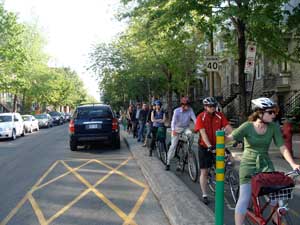
By Jacob Larsen
The blinking lights on Montreal’s new fleet of Bixi bicycles have become a common sight around town, adding to the masses of two-wheeled traffic on the city’s streets and bike lanes. The presence of the new bike-share service, as well as the City’s plan to double the existing network of bicycle paths, aims at making the bicycle a more viable option for sustainable urban transport. However, the mainstreaming of the bicycle poses several challenges in a city that was built around the car, as witnessed last week in the first recorded accident involving a Bixi bicycle.
There are so many different kinds of bicycle paths in Montreal. Some appear out of the blue, and end just as abruptly, reflecting the piecemeal nature of their construction. Consequently, Montreal cyclists are confronted with many types of roads and bike lanes to ride on. Some people may choose to take bicycle paths; others avoid them altogether.
Is this simply due to different types of cyclists, or are some paths objectively better than others? Is Montreal building the right kind of bicycle facilities?
This is just one of the issues underlying a new study of Montreal cyclists by transportation researchers at McGill. Using an online survey, Transportation Research at McGill (TRAM) is conducting the largest and most in-depth research on Montreal cyclists Montreal ever attempted. With the City of Montreal set to build nearly 400 kilometres of additional bicycle facilities, this research will help to inform transportation authorities about Montrealers’ cycling habits to ensure that future bicycle paths result in the greatest benefit to road users.
All Montreal cyclists are encouraged to contribute. The survey can be found at http://tram.mcgill.ca/cycling.html
For more information contact:
Jacob Larsen (lead researcher)
jacob.larsen@mail.mcgill.ca
School of Urban Planning
MacDonald Harrington Building
815 Sherbrooke St. W.
Montreal, QC H3A 2K6
